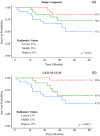Computed tomography-based radiomic markers are independent prognosticators of survival in advanced laryngeal cancer: a pilot study
- PMID: 38095096
- PMCID: PMC11096831
- DOI: 10.1017/S0022215123002372
Computed tomography-based radiomic markers are independent prognosticators of survival in advanced laryngeal cancer: a pilot study
Abstract
Objective: Advanced laryngeal cancers are clinically complex; there is a paucity of modern decision-making models to guide tumour-specific management. This pilot study aims to identify computed tomography-based radiomic features that may predict survival and enhance prognostication.
Methods: Pre-biopsy, contrast-enhanced computed tomography scans were assembled from a retrospective cohort (n = 72) with advanced laryngeal cancers (T3 and T4). The LIFEx software was used for radiomic feature extraction. Two features: shape compacity (irregularity of tumour volume) and grey-level zone length matrix - grey-level non-uniformity (tumour heterogeneity) were selected via least absolute shrinkage and selection operator-based Cox regression and explored for prognostic potential.
Results: A greater shape compacity (hazard ratio 2.89) and grey-level zone length matrix - grey-level non-uniformity (hazard ratio 1.64) were significantly associated with worse 5-year disease-specific survival (p < 0.05). Cox regression models yielded a superior C-index when incorporating radiomic features (0.759) versus clinicopathological variables alone (0.655).
Conclusions: Two radiomic features were identified as independent prognostic biomarkers. A multi-centre prospective study is necessary for further exploration. Integrated radiomic models may refine the treatment of advanced laryngeal cancers.
Keywords: Laryngeal neoplasms; biomarkers; prognosis.
Conflict of interest statement
No competing interests to declare.
Figures




References
-
- Cancer Research UK, Head and Neck Cancers Statistics. In: https://www.cancerresearchuk.org/health-professional/cancer-statistics/s... [23 July 2023]
-
- Amin MB, Greene FL, Edge SB, Compton CC, Gershenwald JE, Brookland RK et al. The Eighth Edition AJCC Cancer Staging Manual: continuing to build a bridge from a population-based to a more “personalized” approach to cancer staging. CA Cancer J Clin 2017;67:93–9 - PubMed
-
- Megwalu UC, Sikora AG. Survival outcomes in advanced laryngeal cancer. JAMA Otolaryngol Head Neck Surg 2014;140:855–60 - PubMed

